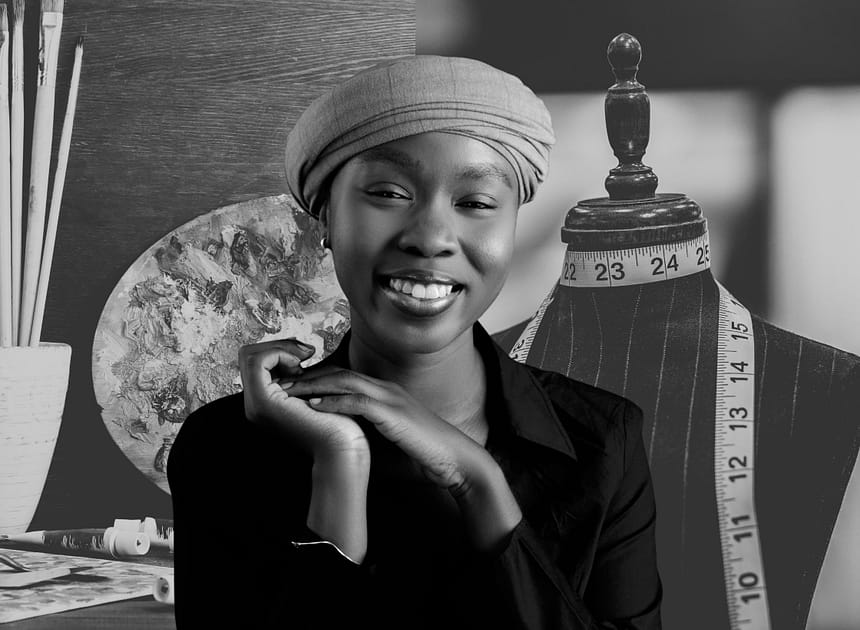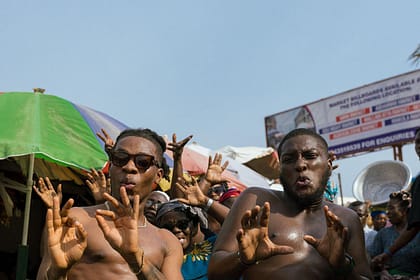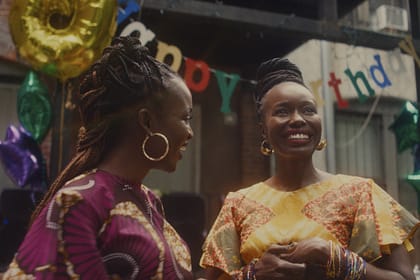In a world increasingly seeking innovation and cultural depth, the intersection of art and fashion stands as a testament to human creativity and expression. At the forefront of this movement in Northern Nigeria is Ganiyat Sani, the visionary behind the Kaduna Fashion and Arts Exhibition (KAFART). The following story is based on a conversation held during the 9th edition of The Moveee’s monthly live culture panel, The Platform, where Ganiyat speaks to Haneefah Abdulrahman on the genesis of KAFART, the inseparable link between art and fashion, and her visions for the future of these dynamic industries.
The inspiration for KAFART came from an observation of Kaduna’s cultural landscape. After returning from her youth service, Ganiyat Sani noticed a significant gap in the local art scene. “I came back to Kaduna, and I was wondering what was happening here? Why don’t we have exhibitions bringing together all these amazing artists we have in Kaduna and even the fashion designers?” This realisation sparked the idea of creating a platform that would not only showcase the rich artistic talent within the state but also make it accessible to the broader community.
Sani, alongside a group of like-minded individuals, envisioned KAFART as a bridge between artists and the public. “Why don’t we just start something like this to provide a kind of bridge between the community and arts so people can have access to these creative outputs and even have interactions with them?” she explained. The primary goal was to increase the visibility of artists who, at the time, primarily worked in their studios, largely unseen by the general populace. “We wanted to make artists more visible than they already were because I felt all these artists were working in their studios. People didn’t get to see much of what art was at the time in Kaduna. Regular people in the community didn’t get to interact much with the creative scene,” Sani elaborated.
The unique name, KAFART, itself has an interesting backstory. It was a friend who suggested shortening “Kaduna Fashion and Arts Exhibition” to the catchy “KAFART”. This simple yet distinctive name has since become synonymous with a pioneering movement in the Nigerian creative industry.
Organising and sustaining an event of KAFART’s magnitude is no small feat, requiring immense persistence and dedication. Sani openly admitted to facing moments of wanting to give up. “I wouldn’t lie, there are times when you want to give up. It gets very challenging and demanding each time, and it sometimes takes a toll on you,” she confessed. Unlike ventures driven by financial gain, KAFART is fueled by a profound passion for the arts. “But it’s not like you’re in for the money or you’re trying to get some money out of this. You’re just trying to do this out of the passion you have,” Sani stated.
What truly keeps KAFART going, despite the exhaustion and demands, is the profound impact it has on the creative community. “The impact on, you know, the way people, especially the creatives—the artists, the designers that participate—benefit from it at the end of the day is kind of what keeps us going. It keeps me going because we didn’t have a place like this in the northern part of the country where we can just go and enjoy like very large scale exhibition, but now we are making this happen,” Sani shared. The realisation that KAFART provides a much-needed platform and a sense of belonging for artists in the region is a powerful motivator. The ethos of “for us and by us” reinforces the communal spirit that drives the festival forward.
The decision to specifically merge fashion and art within KAFART was a personal one for Ganiyat Sani, rooted in her passions. “I’m very passionate about fashion and the arts. So it only makes sense that I decided to create a platform where both can thrive,” she explained. Sani vehemently argues against the notion that art and fashion are separate entities. She believes that fashion, like art, serves a purpose beyond mere aesthetics. “Fashion is something that has a lot of role to play, just like art, beyond just the aesthetics, beyond just the trend, beyond just what you’re wearing or how nice it looks or feels on your body. What more can fashion do and say?” she challenged.
The intersection becomes clear when considering the underlying messages that both art and fashion can convey. “Art is political. Fashion also can be political,” Sani asserted. She pointed to global exhibitions where artists utilise fashion as a medium of expression, prompting viewers to consider the narratives and meanings embedded within garments, rather than just their wearability. “If you see a lot of exhibitions happening globally, you see some artists using fashion as a medium of expression, and it’s not for you to feel like wearing this piece, but for you to actually think beyond wearing this piece to ask, ‘What does this piece actually mean beyond the practicality? Whose narratives are these pieces conveying?'”
Ganiyat also highlighted contemporary designers like Bubu Ogisi, who create pieces that shed light on enduring cultural legacies in Africa. “She creates pieces that shed light on enduring cultural legacies in Africa, and she exhibits these pieces not just for wearing, but for them to actually inspire reflection & conversations around these issues,” Sani noted. This perspective challenges traditional views that sometimes lead artists to be “upset to see fashion in the same space as their paintings or their sculptures”. Ultimately, both disciplines can question, raise awareness, and explore cultural and societal narratives. “Fashion designers are also trying to question or raise questions about certain subjects or talk about certain cultural or societal narratives,” she added.
KAFART has actively championed cultural heritage preservation through various thematic approaches and dedicated projects. Each year, the festival’s themes encourage artists and designers to delve into their histories and cultural contexts, which then inform their creations. “We have artists and designers who take the deep dive into their histories or the cultural context of where they’re coming from and that sort of is applied into their work and you can see that in the kind of pieces they create on the exhibit at our platform, you can see that in the kind of outfits that are designed, just because they’re trying to tell the story,” Sani explained.
Beyond the annual festival, KAFART has initiated impactful programs. The “Hands of Resilience” research volunteer program, launched two years ago, involved young photographers, videographers, writers, and journalists across West Africa. The mission was to “document the current situation of the artists’ communities, focusing on crafts that were dying and are about to be erased, the ones that people are beginning to forget”. This project aimed to preserve knowledge and raise awareness about these often-overlooked cultural practices. “I felt like that was a very impactful project because it allowed people to see what they didn’t know about these craft communities, the current situation, you know, to expand the kind of knowledge that people still had,” Sani said.
Furthermore, KAFART introduced the Co-Cr8 Cross-Disciplinary Artist Residency in 2024. This program brings together artists from various parts of Africa and the diaspora to collaborate and create work. Sani observed that through this residency, artists were naturally drawn to the cultural narratives of the residency location, leading to an “intentional act of actually preserving this culture, preserving this symbolism that is around them.”
KAFART’s commitment to collaboration has been a cornerstone of its success, leading to exciting and innovative work while fostering a strong sense of community. The artist residency, for instance, exemplified this by enabling artists from diverse backgrounds to “create really unique pieces”. These collaborative works were later exhibited at the British Council in Abuja, reaching a broader audience beyond Kaduna. “It was really amazing to see how artists that came from different parts of different backgrounds can work together to create really unique pieces,” Sani said, adding that “few months later the works were taken for a different exhibition at the British Council in Abuja and we’re able to show this work to a broader audience for the very first time beyond Kaduna”.
A notable collaboration was with the National Museum in Kaduna two years ago. This partnership allowed KAFART to showcase works from the Nok terracotta collection, introducing these ancient artefacts to a younger generation who had never seen them before. Sani emphasised the profound impact of this, as it humbled some attendees to learn the history of these “oldest objects in the world”.
Another innovative collaboration was with Grey Hub, a tech company in Kaduna. They utilised virtual reality to exhibit museum artefacts, creating a “digital way of connecting cultural heritage”. This fusion of culture and technology provided an engaging experience for a younger audience. “It was an innovative way, rather, connecting cultural heritage and technology to a younger audience, and we felt that that was really interesting,” Sani stated.
Sani believes that supporting other platforms and individuals is crucial because “it’s really tough in general when you’re doing things alone”. Having experienced a lack of support in her early days, she feels a “sense of responsibility” to be there for others. This empathetic approach is about “breaking a circle of struggle” and building a supportive community, which she sees as “the backbone to a successful structure of anything that you’re building or any kind of community you wish to have”.
The conversation also touched upon the evolving role of technology, particularly AI, in the arts. While acknowledging its potential for efficiency and creating new possibilities for artists and designers, Sani also highlighted the inherent challenges. “With the advent of a new kind of technology, now we’re going to be able to do a lot of things more efficiently as a platform,” she stated. She even envisioned using “moving models, like models that are not really there but like they flesh out the clothes that you’re wearing,” created with software like Blender, to showcase designers’ work.
However, Sani expressed caution regarding issues like plagiarism and the control artists have over their work once it’s fed into AI systems. “It’s also very tricky. At the same time, because there’s so much plagiarism going on, there’s so much, you know, you have to actually be careful with when you’re trying to bring that into your work,” she warned. The threat to traditional roles, such as models, due to AI’s capabilities, is also a concern. “AI is already threatening the jobs of actual models. Some people don’t even need models to model their clothes anymore,” Sani pointed out, adding, “You just feed the clothing to the AI and it has already created the model wearing your piece already.” Despite these advancements, Sani believes there are “still some old school practices that we’re just going to have to keep by the end of the day”.
Looking ahead, Sani envisions KAFART evolving into a physical art centre for experimentation, a space that welcomes people to experiment and be safe to fail. “A place where, if you fail, nobody is making you feel like it’s the end of the world. It is a safe space for artists,” she projected. For the broader art world, especially in Africa, she anticipates exponential growth through “new kinds of artistic medium”. She cited her experience in Cairo, where she saw “people using food as a medium for their artistic practice,” urging African artists to “move beyond canvas and try out things. Experiment a lot”.
Sani also expressed a desire for African art to become more politically engaged. “I don’t think, to be honest, our art is political enough, like there is so much that we need to talk about,” she stressed. She hopes to see art addressing more diverse issues and raising awareness about pressing societal concerns.
When asked what art and fashion can learn from each other, Sani offered a profound insight: “Fashion can learn from art in terms of slowness. I think the fashion world today is too fast, and I think it can learn from art how to slow down,” she stated. She believes this slowing down would allow fashion to be appreciated for its deeper meaning, including its history, identity, and politics, rather than just transient trends. “Slowing down will allow people to actually settle down and think about fashion as something that holds a lot of things like history, identity, even the politics in it,” Ganiyat elaborated.
Conversely, she suggested that art, being inherently open-minded, can readily incorporate and transform fashion. “Art can actually just come and take fashion and actually transform it into something else,” she mused. The ideal scenario, in her view, is for the profound aspects of fashion to be recognised in a mainstream way, beyond niche circles.








